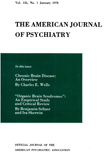CONTROVERSIAL INDICATIONS FOR ELECTRIC CONVULSIVE THERAPY
Abstract
Aside from the recognized indications, ECT was found to be of decisive help in conversion depressions, a syndrome in which somatic, chiefly visceral autonomic features mask the phasic depressive core. Similarly favorable responses were achieved in pseudoneurotic depressive equivalents, conditions that possess the same phasic depressive core as the conversion depressions, whereas the outward symptoms may mimic anxiety states, compulsive-obsessive or neurasthenic syndromes. In anorexia nervosa, ECT breaks up the conditioned behavior pattern and facilitates psychotherapy. Schizoids with superimposed disabling symptomatology of qualitatively neurotic nature, but quantitatively psychotic degree, showed the most gratifying responses inasmuch as the disabling behavior patterns were broken up by ECT. Improvement of anxiety also was observed. Cases of true compulsive-obsessive neurosis never responded. In narcotic addiction, ECT is a highly valuable tool as far as management of the withdrawal period is concerned. The fact that results were obtained in vastly different conditions by the same standard method creates hesitation as to recent tendencies to assign different modes of electro-therapy to different diagnostic categories.
Access content
To read the fulltext, please use one of the options below to sign in or purchase access.- Personal login
- Institutional Login
- Sign in via OpenAthens
- Register for access
-
Please login/register if you wish to pair your device and check access availability.
Not a subscriber?
PsychiatryOnline subscription options offer access to the DSM-5 library, books, journals, CME, and patient resources. This all-in-one virtual library provides psychiatrists and mental health professionals with key resources for diagnosis, treatment, research, and professional development.
Need more help? PsychiatryOnline Customer Service may be reached by emailing [email protected] or by calling 800-368-5777 (in the U.S.) or 703-907-7322 (outside the U.S.).



